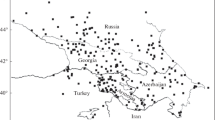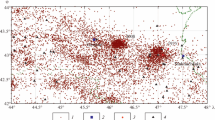Abstract
It is necessary to have reliable data on the distributions of earthquake hypocenters in the study area to solve many geological and geophysical problems, in particular, the forecast of strong earthquakes, seismic zoning, and earthquake-proof construction. In turn, the completeness of the data on the distribution of earthquake hypocenters and the accuracy of their determination largely depends on the effectiveness of the observing system. The efficiency of the modern Carpathian network of seismological observations consisting of 196 stations is estimated in this article. By the effectiveness of the seismological observation network we mean the ability of the network to record events with minimal magnitudes at certain epicentral distances and allowing us to determine its main parameters (origin time and coordinates of hypocenters) with minimal errors depending on the position of the hypocenter of the earthquake. The calculation of the minimum earthquake magnitudes for the Carpathian seismological network shows that if each station has a magnification of 40,000, then the seismological network reliably records earthquakes with a magnitude of 3 or more in the Carpathians. The errors in the determination of the coordinates of epicenters of earthquakes in latitude (δφ) (km) and in longitude (δλ) (km) do not exceed 0.4 km in the center of the network and 1.0 km on the periphery of the network. The values of errors for determining the depths of the earthquake (H) (km) in the center of the network does not exceed 1.0 km and does not exceed 10 km throughout the Carpathian region.








Similar content being viewed by others
References
Antonova LV, Aptikaev FF, Kurochkina RI, Nersesov IL, Rautian TG, Khalturin VI (1968) The main experimental laws of the dynamics of seismic waves. Nauka, Moscow, 289 p
Antonova LV, Aranovich ZI, Kondorskaya NV (1974) Magnitude and energy classification of earthquakes, T.2, IPE AS of the USSR, Moscow. 202 pp.
Aranovich ZI, Akhalbedashvirli AM, Gotsadze OD, Dekanosidze TA (1977) Methodology for calculating the efficiency of a network of regional seismic stations in the Caucasus example. Questions from the automation and automation of seismic observations. Metsniereba, Tbilisi, pp 27–57
Burmin VY (1986) Optimal location of seismic stations for recording close earthquakes. Izv AS USSR Physics of the Earth 5:34–42
Burmin VY (2013) Design of optimal seismic and acoustic networks. Lap Lambert Academic Publishing, Non-statistical approach. Saarbrücken
Burmin VY (2019) Assessment of the Caucasus seismological network effectiveness. Seismic instruments. Vol.55(2), 129–135
Burmin VY, Ahmetyev VM (1994) Errors in determining the parameters of hypocenters of nearby earthquakes, the effectiveness of the system of seismological observations. Volcanology and seismology 2:109–128
Burmin VY, Ngo Thi L, Kondorskaya NV, Akhmet'ev VM (1992) Analysis of the geometry of a modern network of seismic stations and determination of the position of additional stations in the territory of North Vietnam. Izvestia RAS Physics of the Earth 6:123–128
Burmin VY, Nguyen VF, A AM (2000) Planning the optimal regional network of seismological observations on the example of Armenia. Volcanol Seismol 6:66–79
Burmin VY, Nguyen VF (2001) Planning the optimal regional network of seismological observations for Southeast Asia. Volcano Seismol 1:68-75
Burmin VY, Lys NT, Phuong CV (2009) Estimation of modern efficiency and planning of the optimal network of seismic stations in Vietnam. Seismic Instruments 45:27–35
Burmin VY, Lys NT, Fung TK, Le KK (2017) Evaluation of the effectiveness of a new network of seismic observations in Vietnam. Seismic instruments 533(3):74–86
Kondorskaya NV, Aranovich ZI, Solovyova ON, Shebalin NV (1981) Instructions on the procedure for the production and processing of observations at seismic stations ESSN USSR. Nauka, Moscow
Neagoe C, Manea LM, Ionescu C (2011) Romanian complex data center for dense seismic network. Ann Geophys 54(1):9–16. https://doi.org/10.4401/ag-4809
Neagoe C, Ionescu C (2009) Toward a dense real-time network in Romania. Romanian Reports in Physics 61(2):359–366
Popa M, Radulian M, Ghica D, Neagoe C, Nastase E (2018) Romanian seismic network since 1980 to the present. Part of the Springer Proceedings in Physics book series (SPPHY, volume 163), Nonlinear Mathematical Physics and Natural Hazards 117–131pp
Uhrhammer RA (1980) Analysis of small seismographic station networks. Bull Seism Soc Amer 70(4):1369–1379
Uhrhammer RA (1982) The optimal estimation of earthquake parameters. Phys Earth Planet Inter 30:105–118
Verbitsky ST, Stasyuk AF, Chuba MV, Pronishin RS, Verbitsky YT, Keleman IN (2013) Seismicity of the Carpathians in 2012. Seismological Bulletin of Ukraine for 2012(22):1–8
Zoltán Gráczer, Szanyi G, Bondár I, Czanik C, Czifra T, Győri E, Hetényi G, Kovács I, Molinari I, Süle B, Szűcs E, Wesztergom V, Wéber Z, AlpArray Working Group (2018) AlpArray in Hungary: temporary and permanent seismological networks in the transition zone between the Eastern Alps and the Pannonian basin. Acta Geodaetica et Geophysica 53(2):221–245
Author information
Authors and Affiliations
Corresponding authors
Additional information
Publisher’s note
Springer Nature remains neutral with regard to jurisdictional claims in published maps and institutional affiliations.
Rights and permissions
About this article
Cite this article
Burmin, V.Y., Shumlianska, L. Estimation of the effectiveness of the seismological network observations in the Carpathian region. J Seismol 24, 1063–1074 (2020). https://doi.org/10.1007/s10950-020-09916-5
Received:
Accepted:
Published:
Issue Date:
DOI: https://doi.org/10.1007/s10950-020-09916-5




